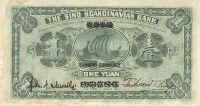| Home | Norwegian Banknotes | Books |  Norsk/Norwegian Norsk/Norwegian
|
| Humour | About janeriks | ||

Custom Search
|
|||
Find Sino-Scandinavian items on eBay
The Sino-Scandinavian Bank
A Chinese banknote with a Viking ship on it? (List of issues, with scans)
Yes, it is true! In the years from 1865 until the 1920's, a large number of foreign banks were started in China. Among these was The Sino-Scandinavian Bank
The history of the bank is a bit obscure, but a "hovedfagsoppgave"
(roughly equivalent to a Master's thesis) from the University of Oslo
1970 by Bjørn R. Rønning sheds some light on the bank.
[Bjørn R. Rønning: SINO-SCANDINAVIAN
BANK (1921-ca. 1927) En norsk bank i Kina? Hovedoppgave i historie
ved Universitetet i Oslo, våren 1970. BIBSYS-referanse ]
In spite of the name Sino-Scandinavian Bank, it was a Norwegian-Chinese operation. The "Scandinavian" may have come from the wish of the Chinese authorities to attract also Swedish and Danish capital and trade. The funding was mainly raised by Chinese parties, but some funding also came from Norwegian sources.
The bank was chartered by the Chinese government on July 21st 1921. The inaugural meeting took place in the main branch office's premises in Peking (Beijing) on September 1st. Operations started on January 7th 1922. The bank probably went out of operation due to bankruptcy between October 8th 1926 and July 1st 1927.
The issuing of notes started on a small scale in 1922. Three signatures can be found on the notes, that of Johan Wilhelm Normann Munthe, that of Fartsan T. Sung and a third that has not been identified.
Rønning has found between 25 and 30 types of notes. The existence of a large number of notes suggests that the bank closed without being able to redeem its notes. Most notes have Sung's signature, suggesting that most notes were issued after his becoming director around July 1st 1924. Note numbers suggest a total of $ 2.5 million may have been issued.
The notes denominated in silver (dollars and cents) have a viking ship as a main motif, but the copper coin notes have a picture of the Great wall as their central motif. A "hovedfagsoppgave" in art history from the University of Oslo suggests from archive findings in the Norges Bank that a series of Polar motifs were planned for notes for this bank, e.g. a Polar bear.
The main characters in the history of the Sino-Scandinavian bank, are:
Johan Wilhelm Normann Munthe (1864-1935). He was born in Bergen, went to China in 1887, participated in the Chinese-Japanese war in 1894-1895 as a volunteer. His background from the cavalry non-commissioned officer's school landed him an instructor's position in the reshaping of the Chinese Army. He was a close associate of the Army chief Yüan Shih-k'ai, and when Yüan Shih-k'ai became the first president of the Chinese republic 1912-1913, Munthe followed him as an aide-de-camp with the rank of lieutenant-general. After the death of Yüan Shih-k'ai in 1916, Munthe was made head of a police force guarding the legation headquarters in Peking. He held this position until his death in 1935.
And, obviously, he was an officer of this Sino-Scandinavian bank, and an important contact both to Norwegian and Chinese authorities.
Munthe was a collector of chinese art, and he bequathed his collection - one of the world's finest - to Vestlandets Kunstindustrimuseum in Bergen.
Harald Skappel (born 1886) was a Norwegian mining engineer who came to China in 1911.
Chiang T'ien-to was a Chinese lawyer and politician.
Fartsan T. Sung (Sung Fa-hsiang in Chinese) was a chemist, educated at Ohio Wesleyan University and University of Chicago. He returned to China 1907 and entered the civil service, from 1912 mainly in the Finance ministry, 1920-23 as head of the governmental press office. He was one of the founders, and from July 1924 managing director of the Peking head office.
|
© janeriks Jan Erik Frantsvåg 2001 Reg.no. NO 983 140
831
Contact me by e-mail: mn@janeriks.no




